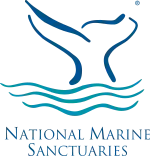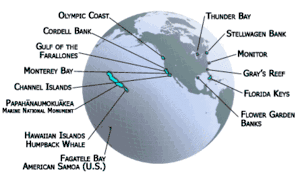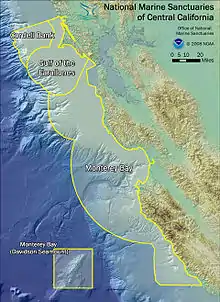 | |
| Agency overview | |
|---|---|
| Formed | October 23, 1972 |
| Jurisdiction | United States federal government |
| Headquarters | 1305 East-West Highway, Silver Spring, MD 20910 |
| Employees | 350 |
| Annual budget | $50 million (2016)[1] |
| Agency executive |
|
| Parent agency | National Oceanic and Atmospheric Administration |
| Website | www.sanctuaries.noaa.gov |
A U.S. National Marine Sanctuary is a zone within United States waters where the marine environment enjoys special protection.[2] The program was established in 1972 by the Marine Protection, Research, and Sanctuaries Act and is currently administered by the National Ocean Service through the National Marine Sanctuaries Act (NMSA).[3]
A U.S. National Marine Sanctuary is a federally designated area within United States waters that protects areas of the marine environment with special conservation, recreational, ecological, historical, cultural, archeological, scientific, educational, or aesthetic qualities. While National Marine Sanctuaries are multiple-use areas, the NMSA emphasizes that one of the express purposes of a sanctuary is to “maintain the natural biological communities” and to “protect and, where appropriate, restore and enhance natural habitats, populations, and ecological processes.” The National Marine Sanctuary System consists of 15 marine protected areas that encompass more than 783,000 square miles (2,030,000 km2). Individual areas range from less than 1 to 583,000 square miles (3 to 1,509,963 km2).[4]
The Office of National Marine Sanctuaries (ONMS), a division of the National Oceanic and Atmospheric Administration (NOAA), administers the 15 national marine sanctuaries. The program began after the 1969 Santa Barbara oil spill off the coast of California brought the plight of marine ecosystems to national attention. The United States Congress responded in 1972 with the Marine Protection, Research and Sanctuaries Act which allowed for the creation of marine sanctuaries. The resources protected by U.S. national marine sanctuaries range from coral reef ecosystems in American Samoa, Florida, Hawaii, and Texas, to shipwrecks in the Great Lakes and the Atlantic Ocean.[5]
The NMSP also is involved in the administration of the Papahānaumokuākea Marine National Monument and the Rose Atoll Marine National Monument, although they are not U.S. national marine sanctuaries. The NMSP jointly administers the Papahānaumokuākea Marine National Monument in conjunction with the United States Fish and Wildlife Service and the State of Hawaii, and it jointly administers the Rose Atoll Marine National Monument with the U.S. Fish and Wildlife Service.
Scope of protection
Designation as a National Marine Sanctuary does not automatically prohibit fishing and other activities. Recreational and commercial fishing is allowed in some sanctuaries. It is possible to restrict consumptive or destructive activities through the initial designation process and NMSP actions. There are restrictions in some sanctuaries that are enforced by other governing agencies. For example, current regulations restricting fishing in Stellwagen Bank were not issued by the NMSP, but rather by National Marine Fisheries Service (NOAA Fisheries} and the New England Fishery Management Council, which have jurisdiction in federal waters off the New England coast generally.[6] The private nonprofit organization Marine Conservation Institute has compiled fact sheets for each sanctuary listing activities which are directly regulated by the NMSP.[7]
Designating Sanctuary Sites
Site selection is done under the auspices of the National Oceanic and Atmospheric Administration (NOAA). Regional teams of marine scientists identify geographically representative sites for potential marine sanctuaries. NOAA then selects candidate sites and meets with state or territorial resource managers and/or the state or territorial governor's staff to determine the local level of interest in establishing a sanctuary. If there is mutually satisfactory interest, the candidate sites are evaluated through a process of public and legislative review and validated by the United States Congress and state or territorial governments. NOAA initiates the designation by the preparation of a Draft Environmental Impact Statement (DEIS) and a proposed management plan, then publishes a notice of its plans in the Federal Register. NOAA sponors regional meetings and public hearings to gather comments. The U.S. Congress receives the draft statements and may conduct its own hearings. NOAA prepares a Final Environmental Impact Statement (FEIS) that addresses the concerns raised in the DEIS process and distributes it for comment. Finally, upon approval of the President of the United States, the United States Secretary of Commerce, who oversees NOAA, designates the area as a National Marine Sanctuary. The U.S. Congress and the governor of the state or territory then may formally object to or appeal the designation.[8]
List of U.S. National Marine Sanctuaries


- Channel Islands National Marine Sanctuary (Pacific)
- Cordell Bank National Marine Sanctuary (Pacific)
- National Marine Sanctuary of American Samoa (formerly Fagatele Bay) (Pacific)
- Florida Keys National Marine Sanctuary (Atlantic, Gulf of Mexico)
- Flower Garden Banks National Marine Sanctuary (Gulf of Mexico)
- Gray's Reef National Marine Sanctuary (Atlantic)
- Greater Farallones National Marine Sanctuary (formerly Gulf of the Farallones) (Pacific)
- Hawaiian Islands Humpback Whale National Marine Sanctuary (Pacific)
- Mallows Bay National Marine Sanctuary (Atlantic)
- Monitor National Marine Sanctuary (Atlantic)
- Monterey Bay National Marine Sanctuary (Pacific)
- Olympic Coast National Marine Sanctuary (Pacific)
- Stellwagen Bank National Marine Sanctuary (Atlantic)
- Thunder Bay National Marine Sanctuary (Great Lakes)
- Wisconsin Shipwreck Coast National Marine Sanctuary (Great Lakes)[9]
Proposed
Notes
- ↑ NOAA Budget Summary (PDF). United States Department of Commerce. Retrieved August 29, 2016.
- ↑ MPP 1, Angela M. Haren (May 25, 2007). "Reducing Noise Pollution from Commercial Shipping in the Channel Islands National Marine Sanctuary: A Case Study in Marine Protected Area Management of Underwater Noise". Journal of International Wildlife Law & Policy. 10 (2): 153–173. doi:10.1080/13880290701347432. ISSN 1388-0292. S2CID 216114235.
{{cite journal}}: CS1 maint: numeric names: authors list (link) - ↑ "National Marine Sanctuaries Act and Legislation | Office of National Marine Sanctuaries". sanctuaries.noaa.gov. Retrieved October 18, 2023.
- ↑ National Marine Sanctuary Frequently Asked Questions
- ↑ Casserley, TR. "Torrid Seas to Icebound Lakes: Shipwreck Investigations within NOAA's National Marine Sanctuaries". In: Pollock NW, ed. Diving for Science 2009. Proceedings of the American Academy of Underwater Sciences 28th Symposium. Dauphin Island, AL: AAUS; 2009. Archived from the original on April 15, 2013. Retrieved March 6, 2013.
{{cite journal}}: CS1 maint: unfit URL (link) - ↑ "About: FAQ: Stellwagen Bank National Marine Sanctuary". Retrieved September 30, 2014.
- ↑ National Marine Sanctuaries » Marine Conservation Institute
- ↑ Fiske, Shirley J. (January 1, 1992). "Sociocultural aspects of establishing marine protected areas". Ocean & Coastal Management. 17 (1): 25–46. doi:10.1016/0964-5691(92)90060-X. ISSN 0964-5691.
- ↑ Briscoe, Tony. "Advisory Council Meeting for proposed Lake Ontario National Marine Sanctuary to meet virtually June 10". chicagotribune.com. Retrieved September 17, 2017.
- ↑ "Underwater sanctuary plan aims to preserve Lake Michigan shipwrecks off Wisconsin". National Oceanic and Atmospheric Administration. Retrieved June 29, 2021.
- ↑ "Proposed Designation of Chumash Heritage National Marine Sanctuary | Office of National Marine Sanctuaries". sanctuaries.noaa.gov. Retrieved April 14, 2022.